Adrian Collins's Blog, page 40
October 9, 2024
Grimdark, Home of the Other
If grimdark is the home of the obscene, perhaps it’s no wonder that it draws in the outsider. Those deemed obscene by the wider world come to grimdark to express themselves without apology.
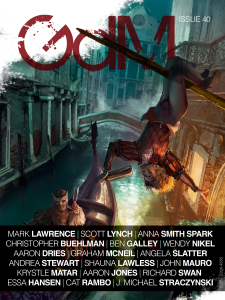 It’s no secret to anyone who knows me that I’m ravenous for the resurgence of Western histfic and Western fantasy. One of my favourites thus far has been Amazon Prime’s miniseries The English (2022) starring Emily Blunt and Chaske Spencer. I was thrilled to watch (and rewatch) my beloved Western setting telling the story of a doomed Englishwoman and a stubborn Pawnee veteran struggling for survival and vengeance in the post-Civil War era.
It’s no secret to anyone who knows me that I’m ravenous for the resurgence of Western histfic and Western fantasy. One of my favourites thus far has been Amazon Prime’s miniseries The English (2022) starring Emily Blunt and Chaske Spencer. I was thrilled to watch (and rewatch) my beloved Western setting telling the story of a doomed Englishwoman and a stubborn Pawnee veteran struggling for survival and vengeance in the post-Civil War era.
The English’s story—which takes place over six episodes—is gloriously violent, blood-soaked, mournful, determined, bleak, hopeful, and beautiful. An absolute smorgasbord for the grimdark fan, The English takes a hard, ugly stare at the history of the American West and how it treated its vulnerable.
Jumping over to books, I recently devoured The Woods All Black by Lee Mandelo, thanks to a glowing review by GdM reviewer Fabienne Schwizer. Fabienne she summed up the powerful novella thusly:
“Set in rural Appalachia in 1929, we encounter a clash between queerness and entrenched small communities—and it’s also in many ways a story still relevant in this day and age, where the hate faced by the trans community has never been bigger.”
It’s not lost on me that some of the most memorable, confronting, and downright cathartic grimdark to cross my path lately has been stories about and/or written by people on the fringes of our era. Voices that refuse to be silenced are turning to fiction and to grimdark specifically where they write the stories of desperate survivors who face their bleak fictional worlds and overcome the brutal worldbuilding the author has conceived, as if to say ‘I will survive this, too.’
Grimdark has become a place where the wounded other can bleed their pain upon the page. The inherent violence in the genre lends itself brilliantly to a kind of healing that comes only when the writer can share the ugliness that lives in their existence. Ugliness inflicted on them by the world at large, ugliness that lives like a scar across their souls. When the world seemed determined to brutalize a person simply because they are themselves, grimdark is the sanctuary where they can expose the brutality and conquer it.
As the world around me spirals into chaos, I find myself retreating to the comforting embrace of grimdark. It’s a genre and a space that seems to understand the complicated mixture of my anger and my hope. It’s a stubborn genre, one that refuses to conform to the greater market. Gossip constantly cycles around that grimdark is dead, that the genre has slid out of its heyday. But grimdark spits the blood out of its mouth and stands straighter than before, supported by the army of the other.
The future of grimdark lies in its diversity. It’s built, one foundation stone at a time, by the resilient and the broken, by the outcast and the survivor. I see the future of grimdark as a protest against the world that tells us we are the obscene. ‘And if we are,’ grimdark says, ‘you made us this way.’
Grimdark survives in the hands of the reader and the writer who sees the beauty in the struggle to keep hope alive. Hope is not a clean thing; it’s hard as nails and covered in blood and wrenched from iron-hard grip of despair. And if we have to get ugly to keep hope in our grasp? So be it.
Long live the desperate hope of those of us deemed obscene.
Long live grimdark.
Read Grimdark Magazine #40The post Grimdark, Home of the Other appeared first on Grimdark Magazine.
October 8, 2024
REVIEW: Lullaby by Daniel Barnett
In Lullaby, Daniel Barnett takes his mania-fueled Nightmareland Chronicles to an entirely new level of human terror as we venture straight into Death Valley. It takes everything that was so darkly intriguing about Nightfall and just dials it up to eleven; this is how you write one hell of a sequel.
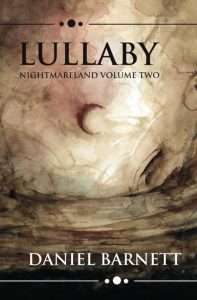 Look, Barnett set the bar almost stupidly high with Nightfall, which is absolutely one of the most ambitious starts to a series I have ever read. And yet, Lullaby did not only meet the quality of its predecessor, but totally exceeded it in every way possible. The storytelling becomes even more intoxicatingly intimate and the looming sense of (psychological) dread only grows more terrifying, which fully established that deep emotional investment that I was yearning for when reading Nightfall.
Look, Barnett set the bar almost stupidly high with Nightfall, which is absolutely one of the most ambitious starts to a series I have ever read. And yet, Lullaby did not only meet the quality of its predecessor, but totally exceeded it in every way possible. The storytelling becomes even more intoxicatingly intimate and the looming sense of (psychological) dread only grows more terrifying, which fully established that deep emotional investment that I was yearning for when reading Nightfall.
Whereas the first book felt a bit scattered in its storytelling with many quick POV switches to different townspeople, Lullaby really narrows down the scope and becomes a much less disorienting (though still properly insane) narrative. Aside from the first chapter, which serves as a little introductory vignette about a deaf boy who comes to play a role in the story later on, we focus solely on John and Mariah as they set off on the promised quest through a world claimed by eternal night to reach John’s estranged daughter.
And to no one’s surprise, their journey soon becomes a road trip from hell. They are haunted and hunted by terrors both internal and external, and Barnett does a scarily terrific job of capturing their raw human emotions on the page. Especially some revelations about Mariah really hit me like a brick, playing into my own deepest aversions and fears in a way I was not prepared for.
Moreover, as I listened along to the audiobook of Lullaby, Adam Gold’s mesmerising and hypnotic narration added a whole extra layer of creepiness to the mysteriously malignant eponymous lullaby that becomes one of the key threats and horror factors in this instalment. At points I felt like his performance had some supernatural force of magic to it that transported me into this horrific narrative without a way back; Barnett’s lyrical yet sharp prose and Gold’s enthralling narration are a match made in heaven, or should I say hell?
While Lullaby doesn’t provide many answers about the overarching mystery of the sudden disappearance of the sun, it absolutely shines in its terrific character development and emotional gut punches. It’s truly insane how much Barnett is able to pack into only 100-ish pages, rapidly filling my black hole of a soul with all the most disturbing and dark delights; The Nightmareland Chronicles honestly transcends genre, it is just raw human storytelling at its very best, and I cannot recommend it highly enough.
Thank you to the author for providing me with an audiobook ARC in exchange for an honest review. All opinions are my own.
The post REVIEW: Lullaby by Daniel Barnett appeared first on Grimdark Magazine.
October 7, 2024
REVIEW: Conan the Barbarian: Battle of the Black Stone #1
After being teased in the 2024 Free Comic Book Day issue and The Savage Sword of Conan #4, the first issue in the Conan the Barbarian miniseries Battle of the Black Stone has arrived. Throughout the first dozen issues of the Titan Comics run of Conan the Barbarian, the title hero has had frequent run-ins with a mysterious black stone not of this world, a substance with a malign, corrosive effect on the people who encounter it. While the ageless sorcerer Thulsa Doom was revealed to have a connection with the black stone (in Conan the Barbarian #12), it was also demonstrated that he was merely someone who harnessed the magical mineral, rather than its progenitor.
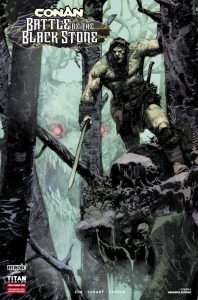 In addition to the stone itself, a crudely carved eye sigil has become a recurring motif. The 2024 Free Comic Book Day issue showed Conan working as a frontier ranger for the kingdom of Aquilonia, years after his initial contact with the stone. After defeating a particularly formidable Pictish tribesman in combat, he finds himself preoccupied with the pendant the Pict wore, bearing this ominous eye-shaped sigil.
In addition to the stone itself, a crudely carved eye sigil has become a recurring motif. The 2024 Free Comic Book Day issue showed Conan working as a frontier ranger for the kingdom of Aquilonia, years after his initial contact with the stone. After defeating a particularly formidable Pictish tribesman in combat, he finds himself preoccupied with the pendant the Pict wore, bearing this ominous eye-shaped sigil.
The first issue of the Battle of the Black Stone miniseries picks up immediately after the 2024 Free Comic Book Day issue. After sensing himself become unusually prone to violent rage, Conan ventures into the Pictish wilderness in search of the sigil’s source. Meanwhile, in 1936 Chicago, occult researcher Professor John Kirowan and his adventurous compatriot John Conrad visit the Wanderer’s Club, an association of world travelers, on their own quest for information about the very same dark eye sigil. They meet with Francis Xavier Gordon, also known as El Borak (“The Swift” in Arabic), but receive a cold reception. Gordon’s own encounter with the glyph in the desert Forbidden Temple (as shown in The Savage Sword of Conan #4) appears to have left him with lingering trauma that he is reluctant to revisit. Inevitably all hell breaks loose at the Wanderer’s Club, however, giving El Borak no choice but to confront his fears.
Jonas Scharf’s artwork manages to distinguish itself from the excellent work we’ve already seen from Roberto De La Torre and Doug Braithwaite while simultaneously feeling completely appropriate for the setting and characters. His scruffy, stubbly Conan appeals, delivering the impression of a man at home in the wilderness.
The dialogue and narration has the same fittingly propulsive feel Jim Zub’s work on Titan Comics’ Conan the Barbarian and The Savage Sword of Conan. As mentioned in my review of the Free Comic Book Day prelude, story-wise, Battle of the Black Stone still feels quite close in execution to the 2019 Conan: Serpent War crossover miniseries Zub wrote for Marvel Comics. Hopefully it will diverge significantly in the issues to follow.
All-in-all, the Battle of the Black Stone event is off to an intriguing start. While not mandatory, reading The Savage Sword of Conan #4 beforehand will enhance the experience with extra character background and the full story of El Borak’s encounter with the dark eye. Even if The Savage Sword of Conan #4 is skipped, readers are encouraged to read the 2024 Free Comic Book Day issue, which is available from the publisher in digital format at no charge.
Read Conan the Barbarian: Battle of the Black Stone #1 by Jim Zub (W) and Jonas Scharf (A)The post REVIEW: Conan the Barbarian: Battle of the Black Stone #1 appeared first on Grimdark Magazine.
October 6, 2024
REVIEW: Nightfall by Daniel Barnett
Daniel Barnett gives Stephen King a run for his money in Nightfall, a post-apocalyptic horror novella that creeps under your skin and feels like a mad fever dream in the best way possible. It’s dark, it’s violent, it’s disturbing, it’s emotional, and most of all, it packs a criminally big punch for a story with such a short pagecount.
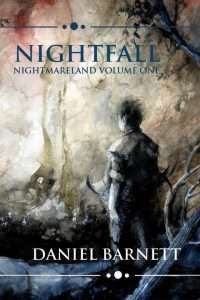 Imagine if one day, for some inexplicable reason, the sun just goes out and people start losing any semblance of their sanity in the darkness. That supernatural scenario might sound like a hellish nightmare in itself, and yet the true horror is soon exposed to be much more realistic and terrifyingly human in nature. Set against the backdrop of a bleak nightmareland of a world, Nightfall gives an unflinchingly brutal and terrifyingly realistic deepdive into the darkest depths of the human mind, grappling with vulnerably raw themes of grief, madness, regret, fear, loss, and love in all its messed up beauty.
Imagine if one day, for some inexplicable reason, the sun just goes out and people start losing any semblance of their sanity in the darkness. That supernatural scenario might sound like a hellish nightmare in itself, and yet the true horror is soon exposed to be much more realistic and terrifyingly human in nature. Set against the backdrop of a bleak nightmareland of a world, Nightfall gives an unflinchingly brutal and terrifyingly realistic deepdive into the darkest depths of the human mind, grappling with vulnerably raw themes of grief, madness, regret, fear, loss, and love in all its messed up beauty.
From the very first page, Barnett’s razor-sharp and intoxicatingly lyrical prose (especially combined with Adam Gold’s exceptionally mesmerising audiobook performance) immediately grabbed me by the throat and then just continued to keep me in a chokehold the entire way through. There’s no denying that I sometimes felt quite disoriented by all the hauntingly disturbing events that unfolded throughout this hectic narrative, but the irresistibly addictive air of mystery and intrigue along with the intimate and emotional storytelling just kept me flipping the pages like crazy.
While Nightfall provides a plethora of different perspectives from the townsfolk of Wrightwood, California, it is first and foremost the story of John Hawthorne and Mariah. I can’t say that I felt emotionally invested in any of these enigmatic characters (yet), but their mysterious allure made them very compelling and they simply popped off the page with personality, for better or worse. Moreover, I loved how their lives intertwined in the most unexpected ways, creating an ominous sense of foreboding that just builds and builds until it all crashes together in a beautifully tragic trainwreck that you just can’t look away from.
Nightfall is the type of story that you just can’t do justice to in a review, because you simply have to experience it on your own to fully understand its brilliance. It’s truly astonishing how much Barnett is able to pack into so few pages, both on a wider world/story level and a more intimate character/emotional level. His storytelling is beautifully efficient, delicately walking the fine balance between making you feel scarily immersed and unsettlingly disoriented.
With this being the first novella in an ongoing serialised adventure horror epic, it very much feels like a set-up book that leaves you with more questions than answers, almost demanding that you come back for more. And you better bet I will dive back into The Nightmareland Chronicles as soon as possible, you know, once I have slightly recovered my bruised emotional state. If you are looking for a short yet unforgettable horror novella that will haunt your mind for days to come, then I can’t recommend Nightfall highly enough, especially as an immersion read with the audiobook!
Thank you to the author for providing me with an audiobook ARC in exchange for an honest review. All opinions are my own.
The post REVIEW: Nightfall by Daniel Barnett appeared first on Grimdark Magazine.
October 5, 2024
Project Starship: Materials Engineering Challenges in Science Fiction
Part of the delight in reading science fiction is seeing how real science can be extrapolated to envision future technologies, whether here on Earth or in extraterrestrial environments. Starships are a ubiquitous presence in science fiction and a prototypical example of technology that can stimulate the imagination of future scientists and engineers. As a materials scientist, I am particularly intrigued by the role of various materials (metals, ceramics, glasses, polymers, nanomaterials, etc.) in building the starships of tomorrow.
The purpose of this science-meets-science fiction initiative, which we are calling Project Starship, is to deepen the connection between the scientific and science fiction communities, helping to stimulate new interest in both fields. To kick off this series of articles, Grimdark Magazine reached out to three leading voices in dark science fiction to explore the materials required for designing the starships from within their fictional universes. First up is Graham McNeill, a British novelist best known for his Warhammer 40k novels, including Nightbringer. Next is Richard Swan, critically acclaimed author of the dark science fiction trilogy, The Art of War. Finally, Essa Hansen is author of the dark science fiction series, The Graven, which begins with the critically acclaimed Nophek Gloss.
The Anatomy of a Starship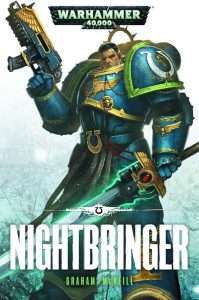 What starships are featured in your sci-fi universe, and what are the technical requirements they need to meet?
What starships are featured in your sci-fi universe, and what are the technical requirements they need to meet?[Graham McNeill] Most of the Imperial starships in 40k are ancient vessels that have plied the gulfs of space for thousands of years and are relics of many lost technologies. They’re gothic masterpieces of cathedral-like command decks, flying buttresses, arches, and temples, many kilometres in length, crusted with centuries of debris and micro-impacts. Their primary technical requirement is to be armoured enough to take punishing barrages as they plunge headlong into enemy formations and to survive traveling through the hell-dimension of the Warp.
[Richard Swan] Largely warships. They must be strong enough to accelerate to incredible speeds and withstand the high inertial forces of turning sharply in three dimensions; they also need to be able to withstand enemy fire (both solid shot and directed energy) and collisions with particulate space debris at near-relativistic speeds. And, naturally, they have to house human beings, weapon systems, electronic warfare systems, et cetera.
[Essa Hansen] The world of The Graven series is unrelated to Earth and leans to the fantastical side of science fiction, meaning I had the luxury of a lot of hand-waving on the technical side. The series world is a bubble multiverse: various-sized bubble-shaped universes stuck together or embedded within one another, with membrane borders, and a different set of physical laws within each universe. The difference in physics might be negligibly slight (small adjustments in this or that math) or wildly and dangerously different (the behavior of the world breaks down as we know it). The easiest way to visualize this is through physical materials and elements transforming, distorting, or breaking down as they pass through the membrane and adjust to the parameters of the new universe. The economy of the multiverse revolves around exploration, trade, and trans-universal transformation, so starships are essential, and being able to travel widely comes down to the particular materials and construction of one’s ship.
The multiverse also features a wide diversity of alien species, which I imagined would have unique designs and materials for their ships, especially in ways that might accommodate non-human biology. For example, what would a space-faring ship look like for an entirely aquatic species?
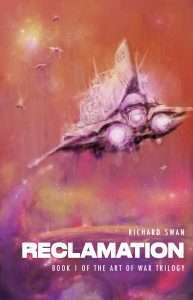 What are some of the materials required to build these starships?
What are some of the materials required to build these starships?[Graham McNeill] Most Imperial ships are built from stone, steel, ceramite, and adamantium: materials that are tough enough to withstand a void-battle and endure travel through the Warp. Ceramite is a kind of amalgam of high-strength steel that is all but immune to heat, which certainly helps when you’re up against alien fleets with plasma weaponry.
[Richard Swan] The ships have 3 layers of shielding to meet these requirements: kinetic force shields, a sort of nebulous cloud of particles that accrete instantaneously when disturbed by objects travelling over a certain speed; nanoform composite ablative armour, which forms the primary physical barrier; and a nanogel non-Newtonian fluid shock dissipater that sits under the outer skin and which absorbs the kinetic energy of anything that makes it through the first two layers.
In terms of materials, I wouldn’t even know where to begin with the force shield—such technology feels a century off at least. As for the latter two, strong but ultra lightweight materials are being created all the time (e.g., graphene), and polymerisation techniques are evolving at incredible speeds. As for the fluids, shear thickening fluids and magnetorheological fluids are both currently being researched by Western defence agencies for advanced forms of body armour. Therefore, it’s not so much a question of new technologies, but refining existing ones.
[Essa Hansen] In this bubble multiverse, there would be universes where it’s possible to have ships with contemporary, non-fantastical materials, but they would be confined to operating within those compatible universes. To have access to the widest range of universes—and thereby, the most personal and economic opportunity—means a starship with materials that are resilient and durable enough to withstand various and repeated translations in physical parameters. I imagined that successful materials would have to be malleable in some way, even organic—versus the rigid forms we commonly see in sci-fi—able to change in structure or in phase to accommodate potentially extreme fluctuations of environment.
One example of such fantastical material is the “Glasliq” ship in the story, conceptualized as being skinned/muscled in a sort of liquid glass or liquid crystal attached around a frame that can fold or give. This alien liquid glass can change phase between liquid, solid, and a cloud of particulates, and take on specific forms sort of like how a ferrofluid changes to magnetic fields. The ability to take on transformations without losing integrity makes the ship resilient to universe changes, lets it pass through obstacles and apertures of various size, and can alter its aerodynamics.
Unless there were a set of ideal materials for trans-universal travel, I think most ships would suffer pros and cons unique to each universe: some materials/construction function better while some things fare worse. This would shift with every new universe. Maybe the electrical system works here, but the armor is brittle. Maybe here we don’t have oxygen, but the artificial gravity is better. Only the titular Azura starship of the series is able to create a small universe of its own around it, bubbling it in constant ideal parameters for its materials. With those physics applied, the sound and function of it described as smoother and more organic, the rigidity and buzzes and separation between components soothed.
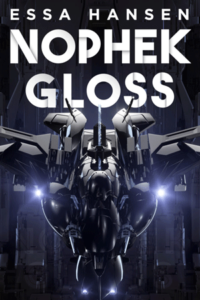 What are the greatest technical challenges for turning the starships of your sci-fi universe into reality?
What are the greatest technical challenges for turning the starships of your sci-fi universe into reality?[Graham McNeill] When 40k ships travel between the stars, they do it through the Warp, a hellish dimension of madness that exists out of time and space, and which is inhabited by all manner of diabolical creatures formed from the subconscious desires and emotions of mortals, so a pretty nasty place overall. To start with, they’d need engines capable of breaching the walls of reality and space/time to ‘translate’ into the Warp. And once they arrive, for a ship to survive, it needs a Geller Field, which is an energy shield that keeps out the immaterial creatures of the warp. Without that, a ship would be overrun almost as soon as it entered the Warp as the hellish monsters can pass through the ship’s armour in the blink of an eye to turn its crew into possessed monsters, drive them mad or otherwise corrupt them in all the worst ways possible.
[Richard Swan] I think creating an armed and armoured spacecraft is very much already possible with current technology. What is lacking is the need, desire, and funding. Indeed, the crew compartments of the International Space Station are already armoured with double-walls, designed to shatter and absorb debris of up to a few mm in diameter. For the ships of my own books, the real impossibility is the FTL drives and communications arrays. Everything else is simply a more advanced version of the technology we already have. Of course, in the actual future, I suspect that almost every military spaceship will be entirely robotic / remote piloted.
[Essa Hansen] As most of the starships in my multiverse are designed to be able to accommodate a wide range of worlds, including ones like ours, they would probably do fine in our reality! They would just be in the tamest possible form, without the wild features that make sci-fi such a fun playground for the imagination.
Materials Considerations in Starship DesignThe materials used in starship design reflect both the technological constraints and advancements within each author’s universe. Starship design in Graham McNeill’s Warhammer 40k novels begins with well-established real-life materials like stone and steel, but also includes realistic extrapolations of new materials like ceramite. Some of the important properties of this ceramite include high thermal conductivity to rapidly dissipate heat from high-energy enemy attacks, as well as high mechanical strength and toughness. Overall, ceramite reflects a conceivable combination of properties based on our known materials science.
 As a metallic alloy that is nearly impermeable to enemy attacks, adamantium is more of a stretch, but still not impossible. Recent development of metallic glass alloys, for example, offers a glimpse of the future of high-performance materials design within the field of metallurgy. The Warhammer 40k universe also features composites of ceramite and adamantium, combining the best properties of these materials to make armor with incredibly high strengths.
As a metallic alloy that is nearly impermeable to enemy attacks, adamantium is more of a stretch, but still not impossible. Recent development of metallic glass alloys, for example, offers a glimpse of the future of high-performance materials design within the field of metallurgy. The Warhammer 40k universe also features composites of ceramite and adamantium, combining the best properties of these materials to make armor with incredibly high strengths.
Composites are also central to Richard Swan’s universe, enhancing material performance by combining the best features of different types of types of polymers, metals, ceramics, etc. Swan goes beyond solid materials, also emphasizing the unique flow properties of fluids and gels, capable of dissipating energy without fracture. Fluids are particularly interesting since they can flow, but they can never be broken.
Materials must withstand the test of time, especially in the Warhammer 40k universe, where much of the relevant engineering knowledge has been destroyed or forgotten. Interestingly, the starship designs in Graham McNeill’s novels are not purely utilitarian: there is also an artistic component to their cathedral-like design, lending a sense of reverence for these marvels of lost technology. Of course, warships must withstand all types of enemy assaults, whether mechanical, thermal, or electromagnetic in origin. The physical laws governing such assaults are especially complicated in Richard Swan’s universe, since as warships approach the speed of light, relativistic effects lead to changes in the passage of time and the apparent mass of the materials making up the vehicle.
Essa Hansen raises an intriguing question of what happens to materials when there are slight changes in physical constants, e.g., when jumping between different universes. Even small variations in what we believe to be universal physical constants (like Boltzmann’s constant or Planck’s constant) could completely change the structure of atoms and how they bond to each other when building different types of materials. Hansen’s novels, therefore, pose unique requirements for multiverse travel beyond anything ever considered in real-life materials design.
I am particularly intrigued by the Glasliq material in Essa Hansen’s multiverse. Real-life glasses combine properties of both liquids and solids. Phase change materials that convert among liquid, crystal, and glassy phases have been critical in the real-life design of rewriteable memory storage. Hansen’s phase change to “cloud of particulates” may be more challenging, but many of the other properties of Glasliq are already within reach.
Altogether, starships from our favorite grimdark science fiction books involve addressing challenges across materials chemistry, physics, and engineering. Our series will continue in future issues of Grimdark Magazine, where we will take a deeper dive into how real materials could be extended to achieve the demanding performance requirement of the spacecrafts of tomorrow. The next article in this series will focus on glass science and technology, understanding how strengthened glass can be developed to offer optical clarity and protection against high-stress mechanical impact. We’ll also explore the science behind phase change materials, such as the Glasliq material used by Essa Hansen in her sci-fi universe. In the following issue of the magazine, Dr. Lourdes Bobbio from Penn State University will share her thoughts on metallurgy in starship design.
This article is published in Grimdark Magazine #40.
The post Project Starship: Materials Engineering Challenges in Science Fiction appeared first on Grimdark Magazine.
October 4, 2024
REVIEW: New York Minute by Stephen Aryan
Take a dash of post-apocalyptic fantasy, add a whole heap of noir crime PI thriller, bake it until it’s dark as fuck, and then you’ve got a perfect Stephen Aryan genre-blending novella. New York Minute by Stephen Aryan is a fast-paced crime story with fantasy set dressing, imagining a world where New York is unrecognizable, with magic beasts we only catch a glimpse of, sword fights in alleys that we can’t get enough of, and a whole ocean of blood spilled in the pursuit of the truth.
“In the inner city, across all of Manhattan, Brooklyn, the Bronx, and part of Queens, the roads are paved with stone. There’s no Staten Island here. That’s the Old Country. Everything old is new again, or at least, the parts of history we can stomach. The rest, our ancestors tried to leave behind and good riddance. They made a mess of the Old Country. That’s one of the reasons we’re here in this new place, trying to do things right this time.”
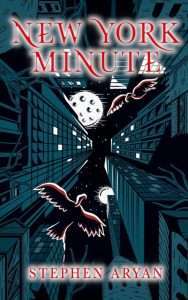 The story that unfolds in New York Minute seems to try to ask who we are as a culture, even when all the trappings of our modern world have been destroyed by some unknown event. What Stephen Aryan manages to accomplish in such a small page count is stunning. Perhaps because he gave us just a hint of a familiar setting and plot (a PI mystery in New York City) we feel grounded immediately, even though his New York has completely changed. Cole Blackstone is everything we want in a noir detective; he’s hard, he’s seen Some Shit
The story that unfolds in New York Minute seems to try to ask who we are as a culture, even when all the trappings of our modern world have been destroyed by some unknown event. What Stephen Aryan manages to accomplish in such a small page count is stunning. Perhaps because he gave us just a hint of a familiar setting and plot (a PI mystery in New York City) we feel grounded immediately, even though his New York has completely changed. Cole Blackstone is everything we want in a noir detective; he’s hard, he’s seen Some Shit , he’s tired, and he doesn’t flinch from violence when it inevitably finds him. His sidekick is tragically doomed and absolutely perfect. And the crime world he has to infiltrate to find a mob boss’s missing daughter is exactly as bleak as we’re hoping it will be.
, he’s tired, and he doesn’t flinch from violence when it inevitably finds him. His sidekick is tragically doomed and absolutely perfect. And the crime world he has to infiltrate to find a mob boss’s missing daughter is exactly as bleak as we’re hoping it will be.
New York Minute uses its small word count to hurdle us through action that’s as gritty and bloody as any Grimdark fan could want, but also to spend a moment considering the human condition. If everything old is new again, can we reset and strive for a better version of humanity? The world that Cole is forced to navigate suggests not. Crime and violence are as familiar to us as blood.
My only ‘complaint’ is that New York Minute was short—I could have devoured a few hundred more pages!
Stephen Aryan has promised this will be a series of novellas after New York Minute, and I for one am first in line for the next Blackstone story. New York Minute should be on every grimdark fan’s TBR pile.
Read New York Minute by Stephen AryanThe post REVIEW: New York Minute by Stephen Aryan appeared first on Grimdark Magazine.
New characters, new map sections, new stories in Vessel of Hatred, the first Diablo 4 expansion
In Vessel of Hatred, the first major expansion for Diablo 4, Nayrelle is on the run and in danger, and you need to find her. In Kyovashad, the glorious few survivors of the incursion into hell have returned, and they are no longer aligned on how to govern their people. There are soldiers in the streets, a new map section to dive in to, a whole new character class to play with, mercenaries, runes, and you, the wanderer, need to find Lorath and Nayrelle before they do. This is everything I’d hoped for from Vessel of Hatred.
 Out of everything the Blizzard team is bringing to the table, the new Spiritborn character is likely the part Diablo 4 fans are most looking forward to. A bit like the old Desert Mercenaries in Diablo 2 crossed with a ninja crossed with a culture heavily invested in spirit animals, the Spiritborn class has clear differentiators from the first release classes, making this a fun new experience. There are plenty of skills and spells to invest in, making the playing experience new and fun, and worth the price of adminssion on October 8. Blizzard’s team have also made sure the class doesn’t miss out on key development opportunities that the other classes have had, even including a self discovery quest to power your character up (which has a boss at the end that is an absolute bastard to finish).
Out of everything the Blizzard team is bringing to the table, the new Spiritborn character is likely the part Diablo 4 fans are most looking forward to. A bit like the old Desert Mercenaries in Diablo 2 crossed with a ninja crossed with a culture heavily invested in spirit animals, the Spiritborn class has clear differentiators from the first release classes, making this a fun new experience. There are plenty of skills and spells to invest in, making the playing experience new and fun, and worth the price of adminssion on October 8. Blizzard’s team have also made sure the class doesn’t miss out on key development opportunities that the other classes have had, even including a self discovery quest to power your character up (which has a boss at the end that is an absolute bastard to finish).
The new area of the map, Nahantu, has a Cambodian / Indonesian temple feel to it, with plenty of jungle around its structures, and some grisly scenes to fight through and discover as part of the story. The black sludge in the rotting jungles, the corruption, and a new evil and minions to slaughter in the thousands continues our hack and slash fun, and so I doff my cap to the art team for delivering another unique feeling region. A fair few minion characters from other regions do get shoehorned in to Nahantu, but I can appreciate the effort that went in creating at least some new creatures to butcher and burn.
One of the things I was so, so freaking excited for was the announcement of mercenaries. Thank the gaming gods, Blizzard brought the mercenaries from Diablo 2 back! They have skill trees so you can mod their combat capabilities to support your own build, but you can’t kit them out like you used to. I’d been holding on to some beasty arms and armour for my mercenary, and to discover I couldn’t pass them on was a bit disappointing from this old grey-haired gamer’s perspective.
Also harkening back to the Diablo 2 days is the reintroduction of runes. For items with two sockets you can slot in a whole new slate of powers. Honestly, it’s like they’ve taken a stack of the things we missed from Diablo 2 and popped them into this game. And I am here for it.
From a story perspective, Vessel of Hatred’s opening cinematic is fucking gorgeous. Once again, the team have captured the filthy, bloody, horrific essence of these games so remarkably well in just a few short minutes. Since I was a kid playing Starcraft at my mate’s place, I have been in consistent awe of Blizzard’s dedication to the cut scene as a storytelling tool.
Diablo 4: Vessel of Hatred is pretty much bang on for what I was hoping for in the first major expansion for this brilliant game. There’s a new class of character that is different and fun to play, a beautifully rendered new map region, the reintroduction of two of the aspects of Diablo 2 that made it one of the best games of its generation, and a storyline that i found fun and engaging. Get your spear and judo kick out, because it’s time to have a bloody great time stabbing and slashing and calling the destructive spirits down on your foes.
Play Diablo 4: Vessel of HatredThe post New characters, new map sections, new stories in Vessel of Hatred, the first Diablo 4 expansion appeared first on Grimdark Magazine.
October 3, 2024
REVIEW: Absolution by Jeff VanderMeer
Last Updated on October 4, 2024
Absolution is the surprise fourth volume of Jeff VanderMeer’s Southern Reach series, which began with Annihilation and continued with Authority and Acceptance. The original trilogy was published in rapid succession ten years ago, all three volumes appearing in 2014, the same year that Adrian Collins founded Grimdark Magazine. It is thus a special treat to review this fourth volume of VanderMeer’s erstwhile trilogy in our tenth anniversary issue of Grimdark Magazine.
 For the uninitiated, the Southern Reach series is a sci-fi horror centered on a mysterious coastal region known as Area X, where biological evolution has been accelerated in unexpected and terrifying ways, presumably due to extraterrestrial interference. Annihilation introduces us to an all-female team of scientists investigating Area X known only by their occupation: a biologist, an anthropologist, a psychologist, and a surveyor. These four women comprise the twelfth expedition into Area X after the successive failures of all the previous missions. The second novel, Authority, turns its attention away from Area X to focus on the Southern Reach, the shady entity responsible for organizing these expeditions into the horrific unknown. The third book, Acceptance, has a broader scope, shifting among several different perspectives and timelines to provide deeper character studies, including that of the mercurial Lowry, sole survivor of the original expedition into Area X.
For the uninitiated, the Southern Reach series is a sci-fi horror centered on a mysterious coastal region known as Area X, where biological evolution has been accelerated in unexpected and terrifying ways, presumably due to extraterrestrial interference. Annihilation introduces us to an all-female team of scientists investigating Area X known only by their occupation: a biologist, an anthropologist, a psychologist, and a surveyor. These four women comprise the twelfth expedition into Area X after the successive failures of all the previous missions. The second novel, Authority, turns its attention away from Area X to focus on the Southern Reach, the shady entity responsible for organizing these expeditions into the horrific unknown. The third book, Acceptance, has a broader scope, shifting among several different perspectives and timelines to provide deeper character studies, including that of the mercurial Lowry, sole survivor of the original expedition into Area X.
Jeff VanderMeer makes a welcome return to Area X with Absolution. This fourth volume of the series is divided into three parts, each leaning heavily into the cosmic horror aspects of the story. The first part of Absolution, called “Dead Town,” can be read as a standalone novella and takes place about twenty years before the formation of Area X. A team of biologists are reintroducing alligators to a region known as the Forgotten Coast. As in Annihilation, the scientists are unnamed, defined only by their professional roles within the team. The biologists take residence at an abandoned village known as Dead Town, their fate becoming inexorably linked to that of the town itself. Meanwhile, the horror elements of the story ramp up with the appearance of carnivorous white rabbits, which give a terrifying twist to classic imagery from Lewis Carroll’s Alice’s Adventures in Wonderland.
In my mind, I had always considered the Southern Reach trilogy to take place on the American west coast, viz., southern California. Although the location of Area X is still unspecified in Absolution, given the strong Karen Russell-style Swamplandia! vibes of “Dead Town,” I believe the Gulf coast of Florida is the more likely setting.
The second part of Absolution, titled “The False Daughter,” takes place about eighteen months before the formation of Area X and concerns the aftermath of the alligator experiment from “Dead Town.” The horrors from the first story come back to haunt characters in unexpected ways. “The False Daughter” features excellent use of the doppelgänger motif, as in Annihilation, and there is also an event known as the House Centipede Incident, which I will not soon forget.
The third and final part of Absolution, “The First and the Last,” recounts the first formal expedition into Area X eighteen months after its formation. The original expedition team has twenty-four members and is told from the perspective of Lowry, the self-described “hero” of the group who is already well-known to readers of Acceptance. The group is woefully unprepared for the journey into Area X, with a lack of professionalism that belies the gravity of the situation. “The First and the Last” is the most interesting story in Absolution, but also the most confounding due to Lowry’s expletive-ridden narrative style, which seems to be competing for gold medal in highest concentration of f-bombs in a work of fiction. In several places, the oversaturation of obscenities gets in the way of telling a comprehensible story.
Altogether, Absolution is the best entry in Jeff VanderMeer’s Southern Reach series since he first introduced the world to Area X in Annihilation. I especially love seeing the many connections between Absolution and the other three books of the series. For readers new to Area X, I recommend reading Annihilation first and then jumping to Absolution. In between, be sure to reserve time for watching the excellent 2018 movie version of Annihilation starring Natalie Portman.
This review is published in Grimdark Magazine #40.
Read Absolution by Jeff VanderMeerThe post REVIEW: Absolution by Jeff VanderMeer appeared first on Grimdark Magazine.
October 2, 2024
REVIEW: The Fury of the Gods by John Gwynne
The Fury of the Gods is the third and final book in John Gwynne’s The Bloodsworn Saga, a Norse-inspired epic fantasy set in the fictional lands of Vigrið. Beginning with The Shadow of the Gods, building with The Hunger of the Gods, and now finishing with this battle filled conclusion, this series has hooked thousands of readers and this book is on many a grimdark fan’s TBR for October. And there’s no doubt that those looking for a satisfying conclusion to the trilogy will find it here, with a side helping of distress and death, of course.
 The Fury of the Gods is time for the final showdown. Lik-Rifa has gathered her forces and is so close to making the world hers that she can taste it. Desperate to rid herself of her sibling (and enemy) gods as well any pathetic humans still resisting her charms (her charms being brutal violence and an all consuming need for domination), she’s set for Snakavik, where those ranged against her are assembling. After all, it’s going to take more than a few swords to kill a dragon god. Most importantly though, the snivelling, snotty Gudvarr is still alive and kicking, hoping to rise in Lik-Rifa’s favour, hovering in the background, trying to be useful to those in power, hungry for personal gain, while also continuing to be utterly contemptible and unjustifiably lucky. Those who know Gwynne know that he would never let that stand forever – watching Gudvarr escape justice repeatedly has felt like an eternal torture – but I knew it would come to an end at some point. Likewise, for all those wronged over the first two books – they have their time. I’m telling you now that it’s worth the wait, but I also come with a warning: not every character you love will come out of these clashes alive…
The Fury of the Gods is time for the final showdown. Lik-Rifa has gathered her forces and is so close to making the world hers that she can taste it. Desperate to rid herself of her sibling (and enemy) gods as well any pathetic humans still resisting her charms (her charms being brutal violence and an all consuming need for domination), she’s set for Snakavik, where those ranged against her are assembling. After all, it’s going to take more than a few swords to kill a dragon god. Most importantly though, the snivelling, snotty Gudvarr is still alive and kicking, hoping to rise in Lik-Rifa’s favour, hovering in the background, trying to be useful to those in power, hungry for personal gain, while also continuing to be utterly contemptible and unjustifiably lucky. Those who know Gwynne know that he would never let that stand forever – watching Gudvarr escape justice repeatedly has felt like an eternal torture – but I knew it would come to an end at some point. Likewise, for all those wronged over the first two books – they have their time. I’m telling you now that it’s worth the wait, but I also come with a warning: not every character you love will come out of these clashes alive…
As always with Gwynne’s work, his most effective scenes in The Fury of the Gods are also the biggest – the set piece battles where everything is at stake and every move is perfectly choreographed – and the smallest – the intimate moments between two characters, where the slightest word or gesture can resonate through the rest of the story. For all that the epic contests are brutal and bloody here, the scenes that hit harder were those with quiet, emotional exchanges. I’ve had a soft spot for Varg throughout and his storyline never ceased to entertain and move. Something about his voice, his love for his sister and his soul-deep desire to avenge her murder, settled into my core and watching how this played out for him was the most tension filled and emotive aspect of this novel. I loved his friendship with his comrades, the growing relationship with one in particular, and felt it hard when he suffered setbacks. He is the epitome of Gwynne’s hero character – determined, brave, thoughtful, caring. I will add him to my growing list of treasured friends, alongside Corban, Storm, Veradis, Drem, and Orka. In a grim world, characters like these, who rise above the petty selfishness, greed, and all the other ugliness of the human condition, offer the light in the dark and they stay bright in the memory as a result.
Finally, I have to say that for me, The Fury of the Gods did not meet the heights of A Time of Courage, the final book in the Of Blood and Bone series, but then, that’s one of my all time favourite finishers. Even so, The Fury of the Gods offers a fun-filled, rewarding finale that grimdark readers will enjoy.
This review is published in Grimdark Magazine #40.
Read The Fury of the Gods by John GwynneThe post REVIEW: The Fury of the Gods by John Gwynne appeared first on Grimdark Magazine.
October 1, 2024
REVIEW: The Devils by Joe Abercrombie
Joe Abercrombie is back, folks, with his highly anticipated historical fantasy horror romp, The Devils— his most action-packed novel to date and the first in a brand new series.
 Europe is in turmoil: the Eastern and Western Churches are in schism and the usurper Empress Eudoxia is dead. Only one thing is certain: the elves are coming and they will eat everyone.
Europe is in turmoil: the Eastern and Western Churches are in schism and the usurper Empress Eudoxia is dead. Only one thing is certain: the elves are coming and they will eat everyone.
In a bid to consolidate power in the East, Her Holiness, Pope Benedicta the First, commands the hapless Brother Diaz to lead a ragtag bunch of ne’er do wells to install a thief upon the Serpent Throne of Troy. Comprised of a self-important necromancer, a geriatric vampire, an undead knight, an ex-pirate, an oversexed werewolf, and a vanishing elf, the Church of Holy Expediency makes haste towards its destination. But Eudoxia’s sons are closing in, and they have their mother’s hideous experiments in tow. To fight devils, one must be prepared to use devils…
Clocking in at well over 500 pages, The Devils makes for a fine bludgeoning weapon in-hand, but whips along at a rapid, raucous pace that had this reviewer devouring it in the space of just 48 hours. Veteran fans will be no strangers to Joe Abercrombie’s beautifully crafted battle scenes and cinematic set-pieces, and I’m pleased to report they feature in abundance here. From a creepy haunted house to the swashbuckling high seas, to a battlefield atop an ancient tomb filled with decaying corpses, the Church of Holy Expediency give us a whistle-stop tour around an absolutely bonkers alternative medieval Europe sure to have the history buffs chuckling knowingly and laughing at an in-joke or two.
At times the fast-paced action sequences and abrupt location changes feel a little too whirlwind—in fact, combined with an ensemble cast and an abundance of new world-building information to absorb, it often feels downright chaotic. However, overall, The Devils’ chaos is enormous fun, and although the break-neck pace may come as something of a disappointment to those who adore the slower, deeper political machinations and character work present in Joe’s The First Law series, it simply cannot be denied that no one writes action as beautifully and as viscerally as Joe:
“He came open like an old coat, insides sliding out in a red-black slurry.”
Pure poetry.
Speaking of character work, Joe’s, as always, is unmatched. In the case of The Devils, it’s the glue holding all the aforementioned chaos together. Although he doesn’t quite plumb the deep dark depths of the human condition as much as he’s done in the past, it’s no small feat that every single one of The Devils’ characters has their own highly distinctive, unique voice—even those who turn up for a chapter or two only to then immediately die (often horribly).
The titular Devils themselves are of course the crowning glory, each of them riffing on a different classic horror monster such as the Wolfman, Dracula, the Invisible Man and many more (there’s even a whiff of the Island of Dr Moreau around some of Eudoxia’s sons’ henchmen). Whilst I’m certain many Grimdark Magazine readers will absolutely love the ridiculously crass and hyper-violent werewolf, Vigga, it’s the necromantic sorcerer—sorry, magician—Balthazar who takes the cake for my personal favourite. His too-high opinion of himself combined with his increasingly desperate, hilarious attempts to remove Benedicta’s papal binding are an absolute joy to read, and a scene in which a Duke is summoned from the depths of Hell legitimately had me laughing out loud for several minutes.
Overall The Devils is fast, furious, and an absolutely rollicking good time. The cast is wonderful, the plot fast-paced and action-packed, and it’s easily Joe’s funniest work to date. It marks Lord Grimdark’s triumphant return to the fantasy genre, and here at Grimdark Magazine, we’re already clawing at the bars and slathering for the sequel.
Read The Devils by Joe AbercrombieThe post REVIEW: The Devils by Joe Abercrombie appeared first on Grimdark Magazine.



